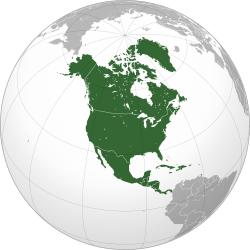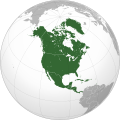
Back ܬܪܥܐ:ܐܡܪܝܩܐ ܓܪܒܝܝܬܐ ARC Партал:Паўночная Амэрыка BE-X-OLD دەروازە:ئەمریکای باکوور CKB Πύλη:Αμερική/Βόρεια Αμερική Greek Portalo:Nordameriko Esperanto Portal:América del Norte Spanish Teemasivu:Pohjois-Amerikka Finnish Portail:Amérique du Nord French प्रवेशद्वार:उत्तर अमेरिका Hindi Portal:Amerika Utara ID
The North America Portal

North America is a continent in the Northern and Western hemispheres. North America is bordered to the north by the Arctic Ocean, to the east by the Atlantic Ocean, to the southeast by South America and the Caribbean Sea, and to the south and west by the Pacific Ocean. The region includes Middle America (comprising the Caribbean, Central America, and Mexico) and Northern America.
North America covers an area of about 24,709,000 square kilometers (9,540,000 square miles), representing approximately 16.5% of Earth's land area and 4.8% of its total surface area. It is the third-largest continent by size after Asia and Africa, and the fourth-largest continent by population after Asia, Africa, and Europe. As of 2021[update], North America's population was estimated as over 592 million people in 23 independent states, or about 7.5% of the world's population. In human geography, the terms "North America" and "North American" can refer to Canada, Greenland, Mexico, Saint Pierre and Miquelon, and the United States, or alternatively, Canada, Greenland, and the United States (Mexico being classified as a part of Latin America), or simply Canada and the United States (Greenland being classified as either Arctic or European – due to its political status as a part of the Kingdom of Denmark, the same goes for Saint Pierre and Miquelon in relation to France), and Mexico being classified as Latin American).
It is unknown with certainty how and when first human populations first reached North America. People were known to live in the Americas at least 20,000 years ago, but various evidence points to possibly earlier dates. The Paleo-Indian period in North America followed the Last Glacial Period, and lasted until about 10,000 years ago when the Archaic period began. The classic stage followed the Archaic period, and lasted from approximately the 6th to 13th centuries. Beginning in 1000 AD, the Norse were the first Europeans to begin exploring and ultimately colonizing areas of North America.
In 1492, the exploratory voyages of Christopher Columbus led to a transatlantic exchange, including migrations of European settlers during the Age of Discovery and the early modern period. Present-day cultural and ethnic patterns reflect interactions between European colonists, indigenous peoples, enslaved Africans, immigrants from Europe, Asia, and descendants of these respective groups. (Full article...)

*A: Cambridge
*B: Newburyport
*C: Fort Western
*D: Fort Halifax
*E: Great Carrying Place
*F: Height of land
*G: Lake Mégantic
This map does not accurately represent the area around the height of land and Lake Mégantic.
In September 1775, early in the American Revolutionary War, Colonel Benedict Arnold led a force of 1,100 Continental Army troops on an expedition from Cambridge in the Province of Massachusetts Bay to the gates of Quebec City. The expedition was part of a two-pronged invasion of the British Province of Quebec, and passed through the wilderness of what is now Maine. The other expedition invaded Quebec from Lake Champlain, led by Richard Montgomery.
Unanticipated problems beset the expedition as soon as it left the last significant colonial outposts in Maine. The portages up the Kennebec River proved grueling, and the boats frequently leaked, ruining gunpowder and spoiling food supplies. More than a third of the men turned back before reaching the height of land between the Kennebec and Chaudière rivers. The areas on either side of the height of land were swampy tangles of lakes and streams, and the traversal was made more difficult by bad weather and inaccurate maps. Many of the troops lacked experience handling boats in white water, which led to the destruction of more boats and supplies in the descent to the Saint Lawrence River via the fast-flowing Chaudière. (Full article...)


Solomon Porcius Sharp (August 22, 1787 – November 7, 1825) was an American lawyer and politician, serving as attorney general of Kentucky and a member of the United States Congress and the Kentucky General Assembly. His murder by Jereboam O. Beauchamp in 1825 is referred to as the Beauchamp–Sharp Tragedy or "The Kentucky Tragedy."
Sharp began his political career representing Warren County in the Kentucky House of Representatives. He briefly served in the War of 1812, then returned to Kentucky and was elected to the U.S. House of Representatives in 1813. He was re-elected to a second term, though his support of a controversial bill regarding legislator salaries cost him his seat in 1816. Allied with Kentucky's Debt Relief Party, he returned to the Kentucky House in 1817; in 1821, he accepted Governor John Adair's appointment to the post of Attorney General of Kentucky. Adair's successor, Joseph Desha, re-appointed him to this position. In 1825, Sharp resigned as attorney general to return to the Kentucky House. (Full article...)

The October 2008 Central America floods were caused by a series of low-pressure areas including Tropical Depression Sixteen, a short-lived tropical cyclone in the 2008 Atlantic hurricane season that made landfall in Honduras. Heavy rainfall began in early October 2008 while a tropical wave passed through the region. On October 14, Tropical Depression Sixteen formed just off the northeast coast of Honduras, and at the same time a low-pressure system was on the Pacific coast. Both systems increased rainfall across the region, although the depression dropped heavy rainfall close to its center when it moved ashore on October 15. Although Tropical Depression Sixteen quickly dissipated over land, its remnants persisted for several days. Another low-pressure area interacted with a cold front on October 21, adding to the rainfall in the region.
Heavy rainfall extended from Costa Rica to southeastern Mexico, causing what was considered the worst natural disaster in the region since Hurricane Mitch in 1998. In the former country, rainfall totaled 2,100 millimetres (83 in) over several weeks, making the week ending October 17 the wettest in San José since 1944. Floods in Costa Rica damaged 32 bridges and roads in 174 locations, while 1,396 homes were damaged, killing seven people. In Nicaragua to the north, weeks of heavy rainfall killed 16 people and damaged or destroyed 1,333 houses. In Honduras where the tropical depression made landfall, rainfall reached 1.2 metres (3.9 ft) in some areas, although the highest official total there related to the depression was 360 millimetres (14 in) on the offshore Roatán over six days. About 40% of municipalities in the country experienced flooding, forcing over 50,000 people to leave their homes. The floods damaged about 50% of roads in Honduras, and over 10,000 houses were damaged or destroyed. Damage totaled about 3 billion lempiras (HNL, $225 million USD), and there were 60 deaths. (Full article...)
Did you know...
- ...that in 1869 the Spanish colonial authorities banned Baseball in Cuba because Cubans began to prefer baseball to viewing bullfights, the Spaniards' national sport?
- ...that the Pewee Valley Confederate Memorial (pictured) is the only American Civil War obelisk monument in Kentucky to be made of zinc?
- ...that the Soufrière Hills volcano is an active complex stratovolcano with many lava domes forming its summit on the Caribbean island of Montserrat?
- ... that the Chontal Maya of Tabasco consider themselves the direct descendants of the Olmec civilization?
- ...that Jacob Piatt Dunn in 1886 wrote the first scholarly history concerning the Indian Wars?
Selected panorama

Topics
Categories
List articles
Related portals
Northern America
Central America
Caribbean
WikiProjects
 North America
North America-
 Canada
Canada -
 Greenland
Greenland -
 Mexico
Mexico -
 Saint Pierre and Miquelon
Saint Pierre and Miquelon -
 United States
United States  Central America
Central America-
 Belize
Belize -
 Costa Rica
Costa Rica -
 El Salvador
El Salvador -
 Guatemala
Guatemala -
 Honduras
Honduras -
 Nicaragua
Nicaragua -
 Panama
Panama  Mesoamerica
Mesoamerica Caribbean
Caribbean-
 Antigua and Barbuda
Antigua and Barbuda -
 Bahamas
Bahamas -
 Barbados
Barbados -
 Bermuda
Bermuda -
 Cuba
Cuba -
 Dominica
Dominica -
 Dominican Republic
Dominican Republic -
 Grenada
Grenada -
 Haiti
Haiti -
 Jamaica
Jamaica -
 Puerto Rico
Puerto Rico -
 Saint Kitts and Nevis
Saint Kitts and Nevis -
 Saint Lucia
Saint Lucia -
 Saint Vincent and the Grenadines
Saint Vincent and the Grenadines -
 Trinidad and Tobago
Trinidad and Tobago
Associated Wikimedia
The following Wikimedia Foundation sister projects provide more on this subject:
-
Commons
Free media repository -
Wikibooks
Free textbooks and manuals -
Wikidata
Free knowledge base -
Wikinews
Free-content news -
Wikiquote
Collection of quotations -
Wikisource
Free-content library -
Wikiversity
Free learning tools -
Wikivoyage
Free travel guide -
Wiktionary
Dictionary and thesaurus
More portals
© MMXXIII Rich X Search. We shall prevail. All rights reserved. Rich X Search
























